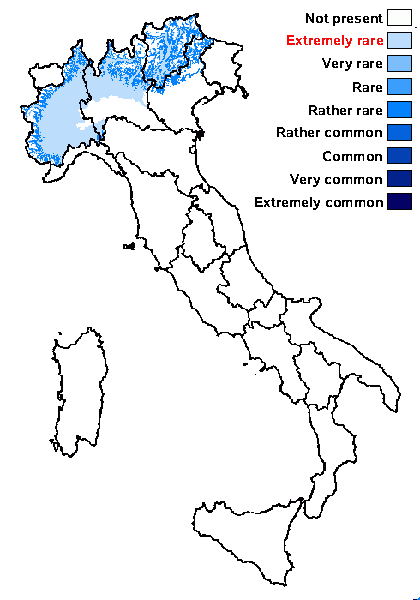Placynthium caesium (Fr.) Jatta
Syll. Lich. Ital.: 38, 1900. Basionym: Lecidea contigua var. caesia Fr. - Lich. Eur.: 302, 1831.
Synonyms: Bacidia caesitia (Nyl.) Jatta; Collolechia caesia (Fr.) A. Massal.; Lecidea caesitia Nyl.; Lecidea triptophylla var. caesia Schaer.; Placynthium caesitium (Nyl.) Hue; Placynthium caesitium f. pseudonigrum Gyeln.; Placynthium garovaglii sensu Malme; Placynthium garovaglii var. subtile Czeika & Czeika; Racoblenna caesia (Schaer.) A. Massal. nomen sed non planta; Scoliciosporum caesitium (Nyl.) Jatta
Distribution: N - Ven, TAA, Lomb, Piem.
Description: Thallus crustose, rimose-areolate, small-warted-granulose, blackish brown but often yellowish-grey pruinose, matt, 1(-1.5) mm thick in central parts, forming convex, 3-5 cm wide patches, sometimes weakly lobed at margins. Central parts covered in densely crowded, 0.5(-0.8) mm long, 0.15(-0.2) mm thick, erect, clavate to cylindrical papillae. Apothecia blue-black, to 0.8 mm across, half-immersed to sessile, with a flat to convex disc and a smooth proper margin. Epithecium dark blue-green; hymenium colourless, amyloid; paraphyses distinctly septate, sparingly branched and anastomosing, hardly swollen at apex; subhymenium brownish. Asci 8-spored, apically thickened, with an apical amyloid ring. Ascospores 3-5-septate, hyaline, cylindrical, (18-)25-35(-53) x (3-)4-6(-7) µm. Pycnidia immersed, 50-120 μm across, the wall blue-green at least in upper part. Conidia bacilliform, (5-)6.5-7.5 x 0.5-1 μm. Photobiont cyanobacterial, Scytonema-like. Spot tests: all negative. Chemistry: without lichen substances. Note: a mainly southern species in Europe, found on steeply inclined surfaces of calcareous rocks with some water seepage after rain. In Northern Europe the species has been frequently confused with P. garovaglii (see Jørgensen 2005), which is a completely different species, although material with poorly developed marginal lobes may resemble P. caesium.
Growth form: Crustose
Substrata: rocks
Photobiont: cyanobacteria, filamentous (e.g. Nostoc, Scytonema)
Reproductive strategy: mainly sexual
On otherwise dry surfaces with short periods of water seepage after rain
Commonnes-rarity: (info)
Alpine belt: absent
Subalpine belt: very rare
Oromediterranean belt: very rare
Montane belt: rather rare
Submediterranean belt: extremely rare
Padanian area: absent
Humid submediterranean belt: absent
Humid mediterranean belt: absent
Dry mediterranean belt: absent

Predictive model
Growth form: Crustose
Substrata: rocks
Photobiont: cyanobacteria, filamentous (e.g. Nostoc, Scytonema)
Reproductive strategy: mainly sexual
On otherwise dry surfaces with short periods of water seepage after rain
Commonnes-rarity: (info)
Alpine belt: absent
Subalpine belt: very rare
Oromediterranean belt: very rare
Montane belt: rather rare
Submediterranean belt: extremely rare
Padanian area: absent
Humid submediterranean belt: absent
Humid mediterranean belt: absent
Dry mediterranean belt: absent

Predictive model
 Index Fungorum
Index Fungorum
 GBIF
GBIF



